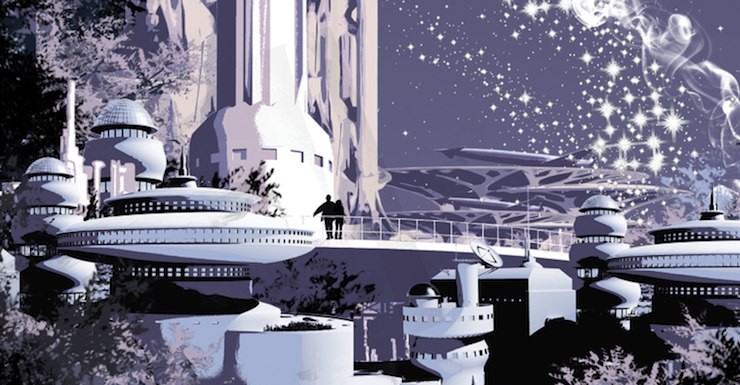A mosaic novel, you say? What’s that when it’s at home? How’s it differ from a common or garden novel? Well, my favourite explanation is from the inimitable Jo Walton: “A normal novel tells a story by going straightforwardly at it, maybe with different points of view, maybe braided, but clearly going down one road of story. A mosaic novel builds up a picture of a world and a story obliquely, so that the whole is more than the sum of the parts.”
According to author Joe McDermott, the creation of a mosaic novel is based on a technique of fracturing one or more story elements: plot, theme, characters, and/or setting. One of these elements, however, should be kept intact to bind the various story threads together and keep the reader anchored in the tale as a whole. Each mosaic text tends to fracture differently, depending on the author’s preferences and the needs of the story. In a true mosaic the plot is always going to be fractured, with no central plotline and each story-tile following its own narrative thread that doesn’t lead to an ending that feeds in to a larger overarching story question. The links between the stories are found in recurring characters and settings, repeated story talismans, themes and motifs, and acts the consequences of which echo through subsequent tales in the mosaic.
Mosiac novels have been written by luminaries such as Nancy Kress, George R.R. Martin, Ray Bradbury, and Richard Bowes, to name but a few (I’ve even committed a few myself). But today I’m going to mention my five current favourites.
China Mountain Zhang by Maureen F. McHugh
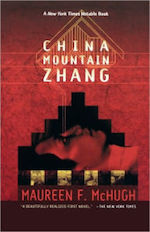 China Mountain Zhang won the Tiptree, Lambda Literary, and Locus Awards, and was nominated for both the Nebula and Hugo awards. It’s the mosaic novel Walton was referring to in the quote above, and it’s one of my favourites. The main story thread follows the life of Zhang Zhong Shan, a man with secrets to hide living an America that’s been utterly changed by a proletarian revolution, the Cleansing Winds Campaign—and basically become an outpost of China. Global warming has made large chunks of the U.S. uninhabitable, and part of the solution to this problem is the settlement of Mars.
China Mountain Zhang won the Tiptree, Lambda Literary, and Locus Awards, and was nominated for both the Nebula and Hugo awards. It’s the mosaic novel Walton was referring to in the quote above, and it’s one of my favourites. The main story thread follows the life of Zhang Zhong Shan, a man with secrets to hide living an America that’s been utterly changed by a proletarian revolution, the Cleansing Winds Campaign—and basically become an outpost of China. Global warming has made large chunks of the U.S. uninhabitable, and part of the solution to this problem is the settlement of Mars.
Zhang is the intersection of all the stories in this mosaic, being involved to varying degrees in with other characters’ lives. Sometimes we have Zhang’s own tale, other times we see him through the lens of another character’s life; these include Martine and Alexi, settlers trying to survive on Mars; Angel who indulges in the dangerous sport of a kite-racing above New York City; and San Xiang, the poster girl for “be careful of what you wish for or you might just get it” cautionary tales. Each character exists in a different part of the world McHugh has created for us, this strange, dangerous, disappointing Chinese-American dream, where everyone has secrets and lies to protect them—just to exist. China Mountain Zhang is a chilling, entrancing, encompassing view of a possible future.
Voice of the Fire by Alan Moore
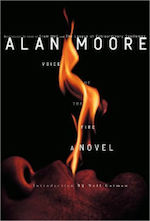 This is a challenging book and I don’t deny it, but it is worth persevering with. The twelve story-chapters form an imagined history of Moore’s birth city of Northampton across six thousand years, where characters recur in various tales and in various forms (first person narrator in one tale, a ghosts or death mask in another). The city is the constant anchor, with each chapter shifting narrator and time period, but using historical and cultural landmarks such as the cathedral and castle, as well as local legends like shagfoals as story talismans to show the reader a Northampton that they both do and do not know.
This is a challenging book and I don’t deny it, but it is worth persevering with. The twelve story-chapters form an imagined history of Moore’s birth city of Northampton across six thousand years, where characters recur in various tales and in various forms (first person narrator in one tale, a ghosts or death mask in another). The city is the constant anchor, with each chapter shifting narrator and time period, but using historical and cultural landmarks such as the cathedral and castle, as well as local legends like shagfoals as story talismans to show the reader a Northampton that they both do and do not know.
That bit I mentioned about a challenge? It’s the opening story, “Hob’s Hog.” The tale is hard to get through because its narrator is a Neolithic, intellectually challenged boy with a way of expressing himself that’s highly idiosyncratic, but it sets the scene for all that follows and the climax is stunning and disturbing and masterful. Other stories are truly astonishing, such as “The Cremation Fields” (in which a murderous young woman tries to lay claim to an inheritance not hers) and “I Travel in Suspenders” (a tale told by insurance fraud murderer A. A. Rouse).
City of Saints and Madmen by Jeff VanderMeer
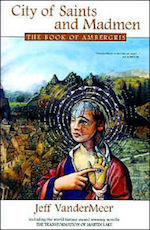 VanderMeer’s City is a magnificent achievement because it has the feel of the kind of document you’d find after the decline of a great civilisation; the sort of archival artefact that would help reconstruct an idea or an impression of a city—but one you’re never quite sure is accurate. City of Saints and Madmen stands as a kind of compendium history of Ambergris, linked by setting and the occasional recurrence of characters in various stories, and story talismans such as the street side saints, the Borges Bookshop, and the legendary figure of Voss Bender, composer and politician.
VanderMeer’s City is a magnificent achievement because it has the feel of the kind of document you’d find after the decline of a great civilisation; the sort of archival artefact that would help reconstruct an idea or an impression of a city—but one you’re never quite sure is accurate. City of Saints and Madmen stands as a kind of compendium history of Ambergris, linked by setting and the occasional recurrence of characters in various stories, and story talismans such as the street side saints, the Borges Bookshop, and the legendary figure of Voss Bender, composer and politician.
One of the unique elements of City of Saints and Madmen is that not all the stories are stories per se: one is a false bibliography, another a history of the famous Hoegbottom & Sons trading house intertwined with an early history of the city, yet another is a series of psychiatric case notes, while others stand as appendices. City of Saints and Madmen functions as a beautiful, fascinating faux historical text and reading it makes one feel like an archaeologist, stripping away the layers of a city’s past.
Accelerando by Charles Stross
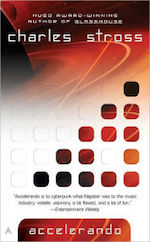 Accelerando is a mosaic saga split across three generations of one family as humanity expands beyond the stars after huge technological advancement. In telling a tale greater than the span of one human lifetime and one single location Stross is able to give a more varied and textured picture of the narrative world in which the characters play out their stories. The anchoring element is the narrator, an AI cat, Aineko, owned by successive family members, and the reader sees the various generational changes through the eyes of the animal. Accelerando won the 2006 Locus Award, as well as being nominated for the Hugo, Campbell, Clarke, and British Science Fiction Association Awards, and rightly so: it offers a vision of a world—a universe, really—vastly changed and virtually unrecognisable.
Accelerando is a mosaic saga split across three generations of one family as humanity expands beyond the stars after huge technological advancement. In telling a tale greater than the span of one human lifetime and one single location Stross is able to give a more varied and textured picture of the narrative world in which the characters play out their stories. The anchoring element is the narrator, an AI cat, Aineko, owned by successive family members, and the reader sees the various generational changes through the eyes of the animal. Accelerando won the 2006 Locus Award, as well as being nominated for the Hugo, Campbell, Clarke, and British Science Fiction Association Awards, and rightly so: it offers a vision of a world—a universe, really—vastly changed and virtually unrecognisable.
Central Station by Lavie Tidhar
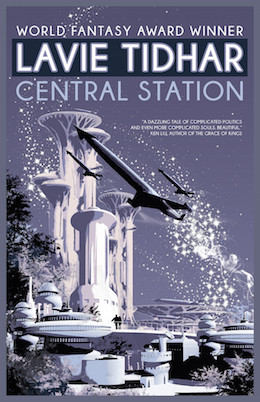 What better way to tell the tale of a diaspora—a dispersal, a scattering, a fracturing—than in a mosaic novel? Tidhar explores life, both virtual and real in this astonishing book: Mars has been colonised, space colonies are inextricably linked in dangerous ways, and earth is home to data-vampires, cyborg soldiers called robotniks, and strange children. This book is peopled by humans, machines, aliens, and everything in between. The space port is the hub where all the stories meet and mingle and here, as the cover blurb says, life is cheap, and data is cheaper. Central Station is vital and vigorous, challenging and mind-expanding, which of course might be said of any of Tidhar’s work, but with each new book he throws out a new challenge to himself and his readers. Blessed be the risk-takers, for they make our reading experiences incredible.
What better way to tell the tale of a diaspora—a dispersal, a scattering, a fracturing—than in a mosaic novel? Tidhar explores life, both virtual and real in this astonishing book: Mars has been colonised, space colonies are inextricably linked in dangerous ways, and earth is home to data-vampires, cyborg soldiers called robotniks, and strange children. This book is peopled by humans, machines, aliens, and everything in between. The space port is the hub where all the stories meet and mingle and here, as the cover blurb says, life is cheap, and data is cheaper. Central Station is vital and vigorous, challenging and mind-expanding, which of course might be said of any of Tidhar’s work, but with each new book he throws out a new challenge to himself and his readers. Blessed be the risk-takers, for they make our reading experiences incredible.
In short, each story in a mosaic novel should be able to stand on its own, but reading them in isolation is rather like looking at one strand of a spider’s web: it won’t give you a true idea about the shape of the entire construct. The connections between these tales are often imperceptible until revealed in the light shed by another story in the mosaic, and the depth of meaning obscured until subsequent tales are read, and then the undercurrents and layers of what’s gone before become clear, making the experience richer and more textured.
 Angela Slatter is the author of eight short story collections, including The Girl with No Hands and Other Tales, Sourdough and Other Stories, The Bitterwood Bible and Other Recountings, and A Feast of Sorrows. Angela has won a World Fantasy Award, a British Fantasy Award, one Ditmar Award, and five Aurealis Awards. She has an MA and a PhD in Creative Writing, is a graduate of Clarion South and the Tin House Summer Writers Workshop. She was an inaugural Queensland Writers Fellow in 2013, and the Established Writer-in-Residence at the Katharine Susannah Prichard Writers Centre in Perth in 2016. Her debut novel, Vigil, was released by Jo Fletcher Books (Quercus/Hachette) in July 2016, and the sequels, Corpselight and Restoration will follow in 2017 and 2018 respectively.
Angela Slatter is the author of eight short story collections, including The Girl with No Hands and Other Tales, Sourdough and Other Stories, The Bitterwood Bible and Other Recountings, and A Feast of Sorrows. Angela has won a World Fantasy Award, a British Fantasy Award, one Ditmar Award, and five Aurealis Awards. She has an MA and a PhD in Creative Writing, is a graduate of Clarion South and the Tin House Summer Writers Workshop. She was an inaugural Queensland Writers Fellow in 2013, and the Established Writer-in-Residence at the Katharine Susannah Prichard Writers Centre in Perth in 2016. Her debut novel, Vigil, was released by Jo Fletcher Books (Quercus/Hachette) in July 2016, and the sequels, Corpselight and Restoration will follow in 2017 and 2018 respectively.










